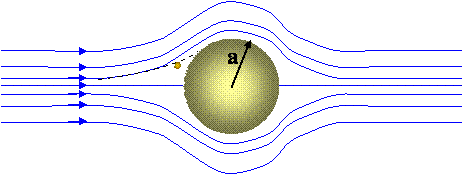




















|
|
Particle Deposition Mechanisms: Impaction Deposition by Inertia Impaction Impaction on Sphere in Cross FlowIn this section deposition on a sphere in cross flow as shown in Figure 1 is studied. |
|
|||||||||

Figure 1. Particle deposition by impaction on a sphere in cross flow.
For particle impaction on a sphere in cross flow, assuming an inviscid flow model, Langmair and Bladgett (1948) found that the capture efficiency is given by

| (1) |
where Stokes Number is defined as

| (2) |
Here a is the radius of the sphere, U is the flow velocity, d is the
particle diameter, and  is
the particle relaxation time. The variation of capture efficiency
as given by Equation (1) is shown in Figure 2, and the result is compared
with the experimental data of Walton and Woolcock (1960), and the
prediction of a viscous flow model. It is seen that the inviscid
flow model given by Equation (1) is in reasonable agreement with the
data of Walton and Woolcock (1960). The viscous flow model
underestimates the experimental data. The earlier data of
Ranz and Wong (1952) suggest higher level of deposition that is
predicted by the inviscid flow model.
is
the particle relaxation time. The variation of capture efficiency
as given by Equation (1) is shown in Figure 2, and the result is compared
with the experimental data of Walton and Woolcock (1960), and the
prediction of a viscous flow model. It is seen that the inviscid
flow model given by Equation (1) is in reasonable agreement with the
data of Walton and Woolcock (1960). The viscous flow model
underestimates the experimental data. The earlier data of
Ranz and Wong (1952) suggest higher level of deposition that is
predicted by the inviscid flow model.


